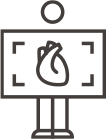THE ROAD TO AN ATTR-CM DIAGNOSIS CAN BE LONG, COMPLEX, AND FRUSTRATING
Awareness among patients, and even physicians, remains low,1 which results in ATTR-CM being significantly underdiagnosed.
Low awareness of ATTR-CM often results in underdiagnosis and misdiagnodis, which can lead to significant health consequences1
- Underdiagnosis and delayed diagnosis occur because the symptoms of ATTR-CM mimic those of other more common causes of heart failure.
- Some ATTR-CM patients report visiting up to 5 different doctors before receiving the correct diagnosis23
TALKING TO YOUR DOCTOR AND CONFIRMING AN ACCURATE DIAGNOSIS IS KEY IF YOU SUSPECT ATTR-CM1
Watch Dempsey’s story about his early ATTR-CM diagnosis.
This is not an actual patient but a model.
It's important to share any symptoms you are experiencing with your doctor. Diagnosing ATTR-CM early is important so that you can begin appropriate treatment.
CLINICAL TESTS TO LOOK FOR SIGNS THAT MAY SUGGEST ATTR-CM
INITIAL TESTS
Your cardiologist may first order the following tests to see how your heart is working and look for signs of ATTR-CM. These tests may include:

Electrocardiogram (ECG)8,24
- Reads electrical signals from your heart
- Can reveal conditions like irregular heartbeat (ie, atrial fibrillation) that may be related to ATTR-CM

Echocardiogram (ECHO)8
- Uses sound waves to create images of your heart
- Findings help determine the speed and direction of blood flow in the heart
- Findings associated with ATTR-CM include, but are not limited to, heart failure with preserved ejection fraction (HFpEF), which relates to the amount of blood that passes through the heart with each beat

Cardiac magnetic resonance imaging (Cardiac MRI)8
- Uses radio waves, magnets, and a computer to create images of your heart to look for abnormalities
While none of these tests are typically used to confirm an ATTR-CM diagnosis, they can help your doctor learn more about your heart and determine the need for additional diagnostic testing.
The clinical tests are to be prescribed by the healthcare provider(s) based on his professional judgement considering the unique characteristics of the patient.
RULING OUT ANOTHER TYPE OF AMYLOIDOSIS AFFECTING YOUR HEART
Your doctor must rule out another form of cardiac amyloidosis, known as light-chain amyloidosis (AL)1:
- This is an important step, as AL amyloidosis and ATTR-CM are managed in different ways
- AL amyloidosis is ruled out using blood and urine tests
DIAGNOSTIC TESTS
Once AL is ruled out, your doctor may use the following tests to diagnose ATTR-CM:

- A small amount of dye is injected into your body
- After 1-3 hours, a special camera takes images of your body
- These images can help your doctor understand if transthyretin(TTR) amyloid fibrils are present in your heart
- Also referred to as a PYP(pyrophosphate) scan

- Your cardiologist conducts the biopsy while you are awake
- If amyloid fibrils are found in the removed tissue sample, it is sent out to a lab
- The lab can help determine if they are TTR amyloid strands or not
- Your doctor may also do biopsies from other parts of your body—but a cardiac biopsy is more accurate to detect ATTR-CM
IF YOU ARE DIAGNOSED WITH ATTR-CM, GENETIC TESTING AND COUNSELING IS RECOMMENDED TO DETERMINE WHETHER YOU HAVE THE WILD-TYPE OR HEREDITARY TYPE.1

Genetic testing1,25
- Will help confirm or rule out the hereditary form of ATTR-CM (hATTR)
- Determines whether family members are at risk, as the mutation that causes hATTR can be passed down
- Usually performed using blood or saliva samples

